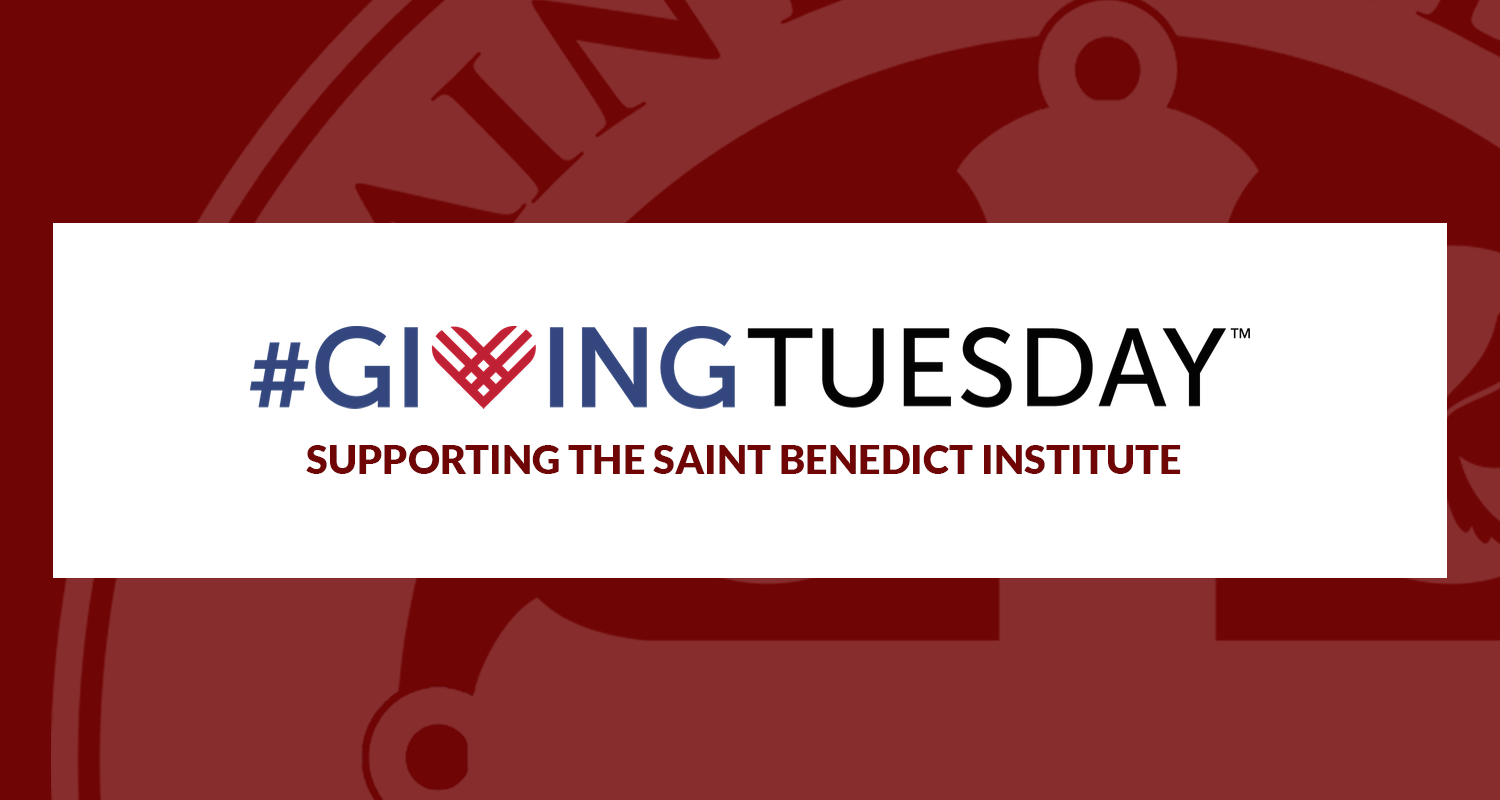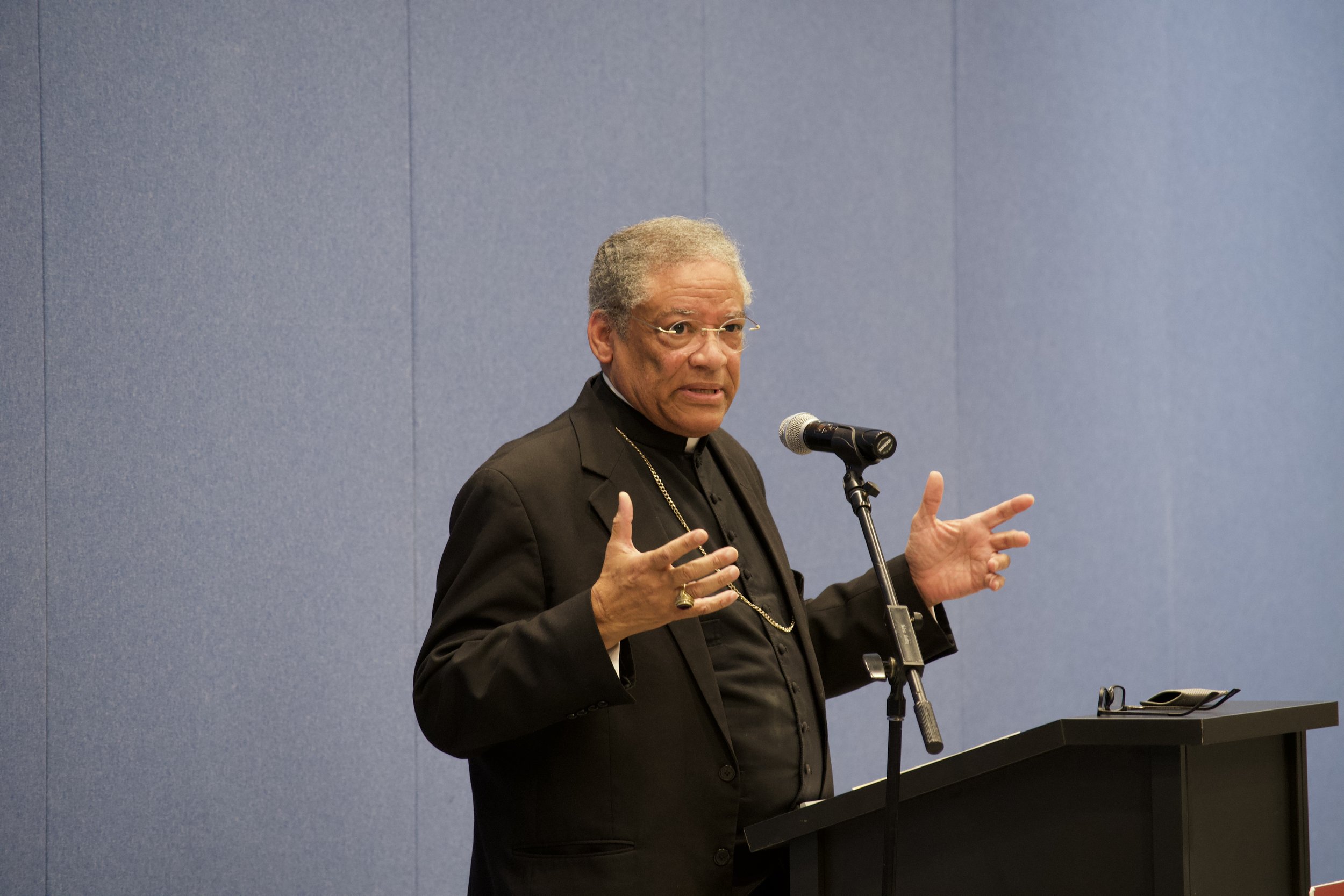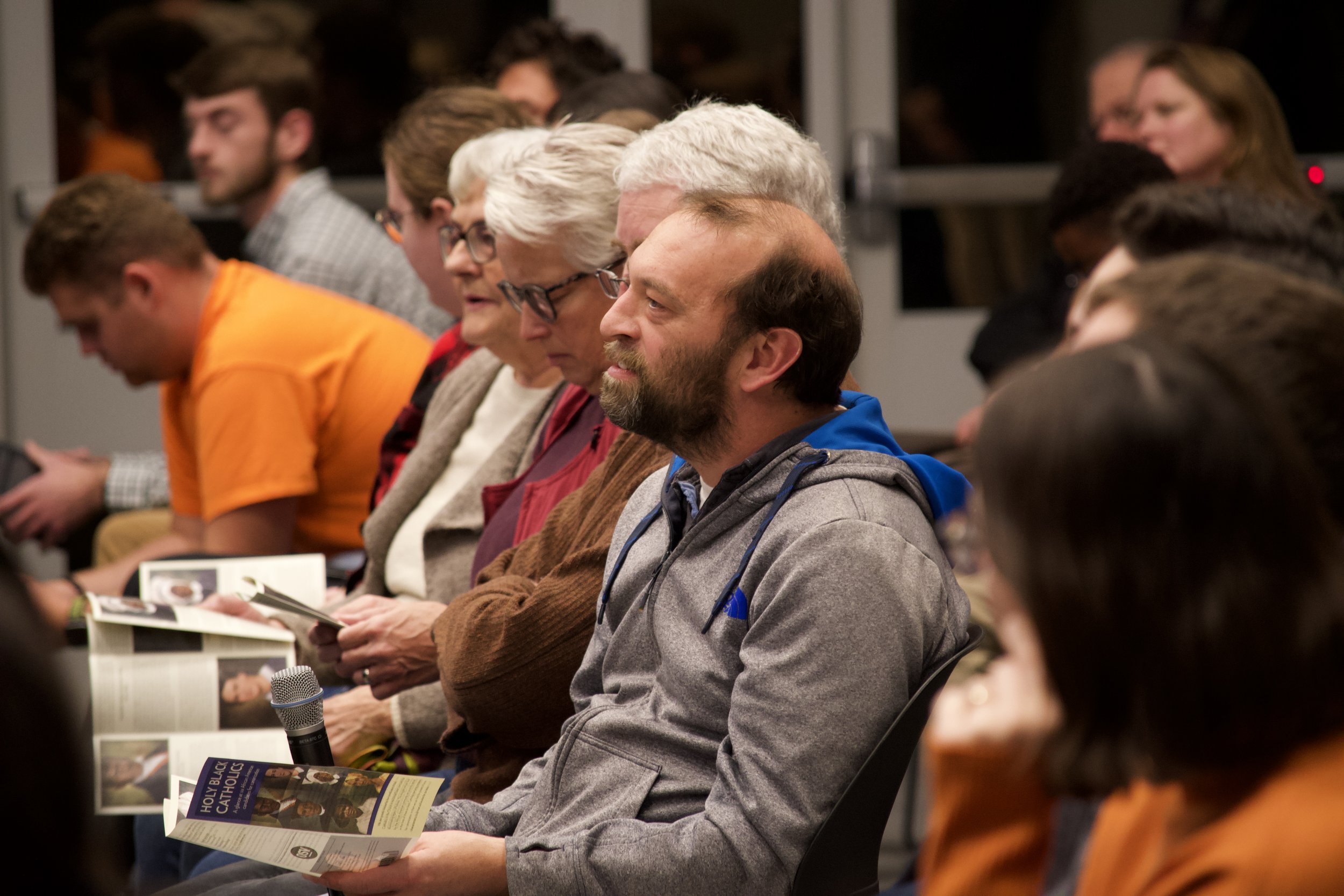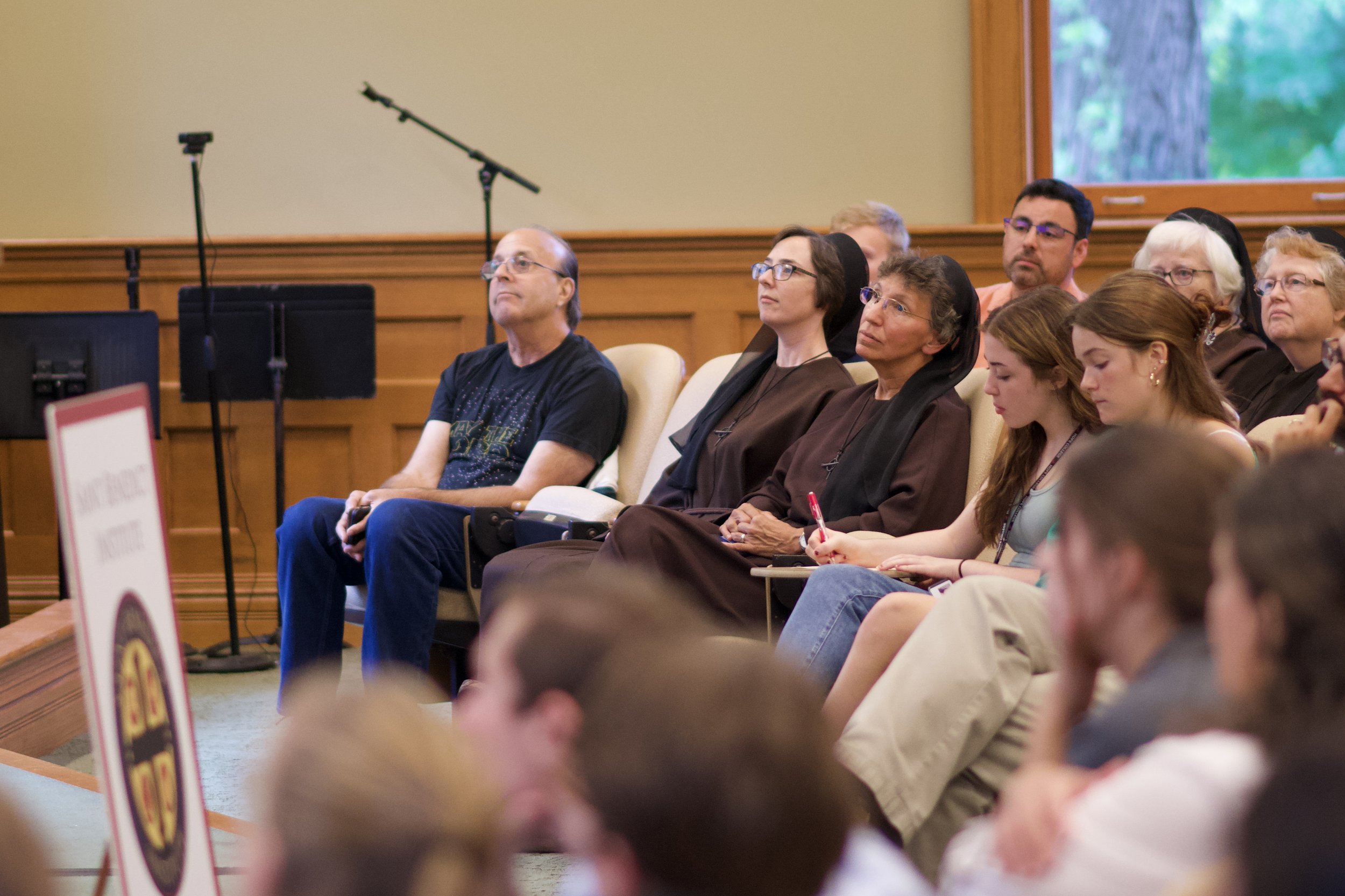Fr. Nick Monco views Veronica’s Veil, a favorite artwork for several of the student curators
Can beauty bring you closer to God? The answer is a resounding “Yes!” according to William Cooke, William Hurley, Karlie Platz, Molly Leonard, and Gabrielle Nelson, the student curators behind Transforming Matter: Incarnation, Sacraments, and Saints in Catholic Art and Devotion.
This exhibition features 25 artworks that reflect different aspects of Catholic theology and religious practice. All of the artworks in the exhibition belong to the Kruizenga Art Museum’s permanent collection and were chosen for display by the five students under the direction of Dr. Jared Ortiz, executive director of the Saint Benedict Institute. You can see the exhibition through May 18, 2024. The KAM is located at 271 Columbia Avenue, between 10th and 13th streets. Public visiting hours are Tuesdays through Saturdays from 10 a.m. to 4 p.m. Admission to the museum is always free.
We met up with William, William, Karlie, Molly, and Gabrielle at the KAM to talk about Catholic art, the curation process, and why people should come see the exhibition. These interviews have been lightly edited for length and clarity.
Dr. Jared Ortiz in conversation at the exhibition
Why are you interested in Catholic art?
William Cooke: Well, we’re Catholic! We [William and William] are both theology majors. I love Catholic philosophy and theology, and it’s really beautiful seeing it expressed in artistic form.
William Hurley: I think that God created beauty as a reality and I think expressing theology and the truths that he taught us through beauty is a way we can learn about him. I think especially through some of the physical relics it also connects Christians nowadays to Christians previously—through relics of the saints, through the physical reminders of the sacraments—and it shows a lot of the faith of the people through things like “Veronica’s Veil” and a lot of the other things we have here. So I think it’s a beautiful expression of Christian truth through beauty.
Karlie Platz: It’s interesting for me because I’m a biochemistry major, so art is not my natural habitat necessarily. I’m also a religion major, so I’ve spent some time learning about the history and theology of the Church, and art has a big role to play in that. It’s a very tangible representation of that and how the Church has been evolving over time.
Molly Leonard: I’m a math major and a religion major, so art’s not one of my natural inclinations either, but I think it’s one of the really cool ways that God reaches us. Especially in the Catholic tradition we see that God can work through different people’s gifts to show a lot of different skills and beauty. I think we’re able to draw on that and learn a lot from different cultures.
Gabrielle Nelson: I’m an art education major here at Hope, so Dr. Ortiz asked me to be a part of this show because of that and because I’m Catholic. Growing up, I have been immersed in the beauty of Catholic art. My mom’s an iconographer, so I’ve always had this deep appreciation for the beauty that the Catholic Church presents. I was really excited to be invited by Dr. Ortiz to be a part of this show because I think that’s one of the most important parts of our faith—the beauty that we can depict, along with our faith that we all share.
William Cooke with an Ethiopian icon of the Last Judgement
What was it like working with your fellow curators, Dr. Ortiz, and the Kruizenga Art Museum team?
William Hurley: It was great. It took a while, but that’s just how this stuff works out. I think it was really great especially because Dr. Ortiz could check all of our stuff and make sure it all flows together. We developed seven different ideas and were able to synthesize it all into this one journey. I think it was really nice, and of course Dr. Ortiz and the other Catholics were really great to work with, and they brought a lot of theological and artistic knowledge to the table.
William Cooke: And the museum staff were really great to work with too. A lot of us were dropping by here and looking at stuff and rearranging and toying around with it for a while. It was really cool seeing it emerge from nothing, everyone throwing out ideas and tweaking it, and it becoming something really coherent that we’re all really proud of.
Karlie Platz: Dr. Ortiz was an excellent organizer. We started way back in the spring just perusing the museum and looking at these things. The thing that struck me the most was that I was so surprised that all this art was here. In the basement of this museum we had these relics and these beautiful crucifixes and monstrances and things. That was exciting and surprising. Then once we actually started working together and figuring out what was going to go where, it was really beautiful that this story emerged, working from the Incarnation to the Resurrection.
Molly Leonard: It was really cool to get to tell a story. Dr. Ortiz did a really good job organizing it and making it so it wasn’t super logistically hard for us to do. We still got to do a lot of the fun stuff of picking out different pieces and trying to draw out what was really cool and beautiful about them artistically and also theologically. In writing about them we got to play to our strengths and also get to work together and make a really cool project out of it.
Gabrielle Nelson: We had a couple meetings to decide what we were picking out. Charles Mason has a ton of pieces here that are Catholic, and some were Catholic art but not made by Catholic artists. We decided to go with a strictly Catholic artists show. We deliberated and we talked about the pieces. The KAM has a website where we could decide on a gallery that we could add each piece to. We wrote down our favorites and prayed about it and then came together. The museum did the rest. Dr. Ortiz had us write about each section and research.
William Hurley with the monstrance, ciborium, processional crucifix, Defenders of the Eucharist, and Veronica’s Veil
What’s your favorite work of art in the exhibition and why?
William Hurley: I’d have to pick the ones that I wrote about. I love the ciborium a lot, and the processional crucifix, and of course the monstrance. Those are the three that are my favorite. They’re so awesome because they’re sacred objects which are used in the liturgy of the Church, the divine worship that’s due towards God. That’s one of the things I love the most as an altar server: to be that close to God when these things are happening. These things are reminders of that. Veronica’s Veil is the other one that was really impressive that I did not write about.
William Cooke: I wrote about the Asian, Ethiopian, and Mexican sections. It’s really hard to choose. If I had to choose one outside of my section, it would probably be Defenders of the Eucharist. I also really love the relics. They’re really beautiful and there’s the added level of sacredness—having actual sacred objects that we get to show.
Karlie Platz: The section that I wrote the descriptions for was the Incarnation section. Naturally they have a special place in my heart because I spent so much time thinking about them. The one that sticks out to me the most is the etching of Veronica’s Veil. There’s something about when you look at it, it’s so powerful, the face of Christ, it looks like he’s weeping a little bit. It really strikes you to the heart. It’s also from an artistic point of view very interesting. I didn’t realize this at first when I first saw it—I just thought it was this beautiful drawing. It’s actually a single line that starts in his nose and spirals out to make this beautiful image. You wouldn’t even realize it until you look at it. It’s almost like this double symbolism. Of course the symbolism of Veronica’s Veil is that this veil—this matter—is transformed into this holy object. But then for the artist it’s even something as simple as a line can be transformed into this beautiful picture. I thought that one was really powerful.
Molly Leonard: I wrote the saints and relics section so those are my favorite pieces. It’s hard to pick a favorite. I like the St. Anne relic because we have the St. Anne Oratory here. And I didn’t really realize how intricate it was until yesterday when I was looking closer at the relic, because I don’t think I had seen the reliquary up close. There are little angel heads around the relic, which is really cool. And just the fact that we have the reliquary here and the significance that it holds to Hope’s Catholic community is really special.
Gabrielle Nelson: I just love the Last Supper piece... I go back and forth! All the pieces look different, too, now that they’re hung up. I think probably the St. Nicholas icon, just because he’s my patron, so I have a super close connection to St. Nicholas. Also, since it is an icon, I see my mom every time I go home she’s making icons and painting, so it’s really cool to see a different application of that medium as well as to see the history behind it that I don’t really see with my mom painting brand new ones at home.
Karlie Platz with several images of the crucified Christ
What did you learn while curating the exhibition? How has it affected you academically and spiritually?
William Cooke: Through doing this, I got a better sense of the breadth of the Catholic artistic tradition. Seeing all the different art movements and cultures through which the faith is expressed has been really enlightening. There’s a lot of history you connect with looking at this.
William Hurley: I’m used to a lot of statuary and metalwork, that kind of stuff, and to see, especially the Asian art that I’m not really in contact with living in the West, that was really inspiring. Things like Veronica’s Veil—before this I actually hadn’t heard about the specific way of that drawing. I see that as a little miracle in and of itself.
Karlie Platz: I’ve always known that the word “catholic” means “universal,” this idea of the Universal Church, but seeing this art from all the different cultures and the different ways even within one culture that different individuals represent their faith, really visibly and tangibly made the reality of the universality of the Church present to me. I think that was my biggest takeaway.
Molly Leonard: It was really cool to reflect on the Catholic faith as a really distinctly incarnational one and the different ways that plays out: the saints and the sacraments, the relics and things like the Last Judgement. It was really cool to see how it is displayed in so many different themes throughout the exhibit, the way we were able to bring that story to life.
Gabrielle Nelson: I think I came in knowing a decent amount about the curation process, but I definitely learned a lot more through working with Charles. I had no idea the KAM had so many Catholic art pieces! It was really cool to see that, even though Hope is obviously not a Catholic school. But then I also feel like my personal faith grew a lot because I was moved to really look into the images that we selected, particularly for the Last Things section, that I had to do the research on the artwork itself. I do that in my art classes, but I don’t always get to experience that with Catholic art. Really diving into the truth of the Catholic faith through that and using all three transcendentals of truth, beauty, and goodness and working from each within the pieces and my own faith growing. Even things that I already knew were reiterated.
Molly Leonard with the reliquaries on display at the exhibition
Why should people come see this exhibition?
William Hurley: I think that it takes you on almost a whole journey of Christ and how he is trying to reach us and the world. It’s an excellent summary, kind of a mini-catechism, and done in a very reachable, beautiful way. It’s not some stuffy theological document that’s hard to read. It’s a thing that’s expressed through emotion and beauty. Specifically, Defenders of the Eucharist was another thing that I really like as well, that shows in a beautiful way people’s love for the real transformation of matter that we have.
William Cooke: God is beauty, and experiencing him through art—this is a way to God. It’s a unique way of experiencing God, and this is our shared heritage, so this is also a way of being close with all the Christians who have come before us.
Molly Leonard: Especially because we’re on a Protestant campus, a lot of people just don’t know a ton about the history of the Catholic Church and the deep faith tradition that we have. We tried to give a pretty cohesive view of what we believe as Catholics. There’s a lot that we’re trying to show. Also, I think we have some really cool art, and we just had the opportunity to show it. Otherwise, it’s just going to sit in the basement.
Karlie Platz: I think about the story of the Catholic tradition that can be learned. Also, there is something divine in all of the matter around us, and I think coming to look at this art and reflect upon that can help awaken our senses to that reality.
Gabrielle Nelson: A lot of people have misconceptions about Catholic art. Just entering this space they’ll see the beauty and how it draws you into something deeper. Even if there are no misconceptions, we’re made to see beautiful things and walking through this gallery can grow you closer to God and show you more of God through beauty.
Gabrielle Nelson with artworks in the Last Things section of the exhibition















































































